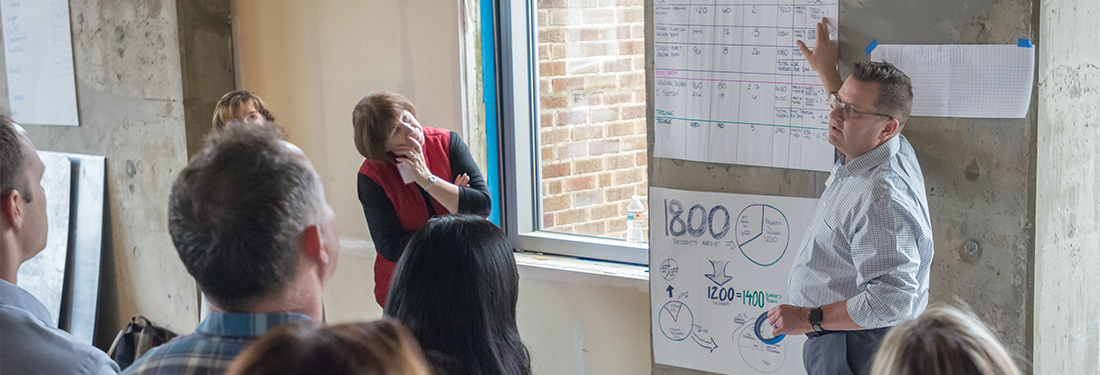How Can Lean Improvement Work Engage Staff and Reduce Costs?
An interview with Cathie Furman, executive faculty member at Virginia Mason Institute
When you’re doing lean work, how do you measure ROI?
CF: That’s a question we hear all the time. When we first started on our lean journey in 2001, our board agreed we would not measure ROI for that year. They were committed to the business case for quality, and in their eyes, if we focused on quality and safety, the financial improvement would come.
That’s why, during the kickoff for all our kaizen [improvement] events, our sponsors told our teams that we needed to find innovative ways to get out of our mental valleys and assumptions about improvements — using no new capital, no new space and no new FTEs [full-time employees].
And the tenets we abided by in 2001 are the same as the tenets now. We’re focused on sustaining a culture of continuous improvement across the organization, and we see the financial rewards when we measure ROI over the long term. Taking employees offline to participate in improvement work carries an initial expenditure in resources, but we know that engaging our employees in the work is an important investment. It’s essential for the long-term results in quality, safety and cost that we want.
Can you describe some improvement work that has saved money for the organization?
CF: There are numerous examples. During one RPIW [Rapid Process Improvement Workshop] with our gastrointestinal team, the team had thought they needed six new procedure rooms to take care of pent-up demand. But by the end of the week, they were able to drastically increase quality and throughput to meet demand. They saved more than $2 million in capital expense.
In primary care, we’ve reduced the waste of processes so that we see more patients in a shorter period of time — another example of improved throughput. Just as important, our primary care providers are operating in the black now and getting home in time to have dinner with their families — a huge satisfier. In parallel, the turnover rate for primary care providers has dropped significantly.
In our administration department, each executive used to have one executive assistant. In our improvement work, we discovered the waste in the scheduling of meetings, in calendaring and in answering phones. The team developed standard work and reduced their processing time. Now it’s down to one assistant for every two or three executives.
And there’s one that we tell people about all the time: After we implemented our Patient Safety Alert System™ and empowered more than 5,000 safety inspectors, we saw a drop in malpractice premiums that today is about 75% less than it was more than a decade ago. And the reserves we used to place whenever we had a potential claim dropped substantially, freeing up that money to be reinvested in the company.
In our financial department, we’ve reduced payroll defects and increased the turnaround time in bill posting. In our supply chain work, we’ve had huge cost savings, and we’ve shown substantial reductions in workers’ compensation claims because of our lean work in reducing the number of surgical instruments our employees carry and clean every day. The list goes on and on.
When the teams cut waste and cost, are they also cutting jobs?
CF: No. We agreed in the beginning that we would not lay off workers as a result of improvement work, and we’ve stuck by that. Often we’re actually cutting out only part of an FTE’s job, and that provides more time to focus on their work and reduce the chaos our staff used to experience on a daily basis. It has also become an important source for talent development. One great example is some lean work that made our audiology department more efficient, which freed up one of our audiologists to become a project manager. She was so good at it she eventually moved to our kaizen promotion office. Today she’s guiding teams across the organizations in improvement work.
“We’ve got assistant nurses, pharmacy techs and cardiologists who have grown in their positions and are now leading improvement events and improving care every day. Lean work has become a springboard for helping our people become leaders.”
– Cathie Furman
Why is talent development so important to the organization?
CF: We’re being more disciplined and using our lean tool that calculates the number of operators needed to best serve our patients. We ask, “What is this operator spending her time on?” For job satisfaction and talent development, we’re becoming more disciplined. Skill-task alignment is key.
Staff should be working at the top of their licensure. What we learned in inpatient nursing is that 90% of our nurses were hunting and gathering supplies versus spending time at their patients’ bedsides to take care of them — which is what they were trained to do and wanted to do. After our improvement work, our medical assistants spent less time answering the phone and rooming patients and more time giving injections and administering EKGs, using the skills they went to school for. Turnover rates have gone down because it’s important to us to engage our staff every day. Today our staff members want to invest the time and energy in making things better for our patients.
And it’s not just nurse engagement. It’s for every position. We’ve got assistant nurses, pharmacy techs, and cardiologists who have grown in their positions and are now leading improvement events and improving care every day. Lean work has become a springboard for helping our people become leaders. We don’t want our employees to get bored and leave. We want to develop their talent so that they’re always learning. It’s part of our culture.
What roles do the leaders play in the improvement work, and what roles do the other team members play?
CF: Leaders are the problem framers rather than problem solvers like in the traditional leadership role. They find out all the defects in their area of accountability through observations at the front line, and they help the team prioritize to find out what’s most important. Then the leader’s job is to scope the process improvement work, get a team together and remove any barriers the team runs into.
They also empower the people who do the work. When they do that, the employees tell them the new way to do the work. Executives can come up with ideas, but they must engage the workers to make the ideas become the new work.
What advice would you give a leader who wants to improve his or her organization?
CF: Get out and watch the process. The first time I observed the infection prevention team doing their daily work, I had tears in my eyes when I saw the system they had to deal with. It was so broken. There were about 300 patients and 3 infection prevention specialists, and our team had to deal with reams and reams of paper with disorganized information and manually matching the pieces that belonged to their different patients before they could even start to figure out what was going on. It was a terrible feeling to realize that we hadn’t been helping our people do their work. After our improvements, our team saved hours and hours of time and were helping their patients much more quickly and efficiently. Our lean work made a difference for our patients, our staff and for the entire organization.





